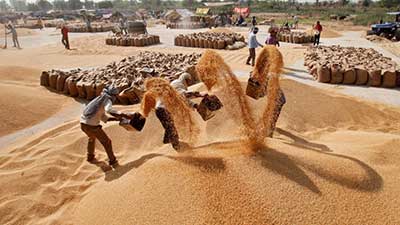Date: 22/02/2023
Relevance: GS- 3: Major crops-cropping patterns in various parts of the country, - different types of irrigation and irrigation systems storage, transport and marketing of agricultural produce and issues and related constraints.
Key Phrases: Inclusive Growth, Sustainable Growth, Agriculture Model, BIMARU States, Green Revolution, GDP Growth, Horticulture, Environmental Sustainability.
Context:
- Madhya Pradesh has performed very well and has clocked the highest growth rate in agriculture at 7.3 percent. A well-diversified portfolio in crops is behind the high growth in the state's farm sector. This is inclusive and sustainable and offers a path for other Indian states.
Key Highlights:
- India's current economy stands at $3.5 trillion and is forecasted
to reach $5.4 trillion by 2027, according to the IMF.
- While external factors such as the Covid-19 pandemic and the Russia-Ukraine conflict may cause some delay in India's target of becoming a $5 trillion economy by 2025, it remains achievable.
- It took almost 59 years since independence for India to become a $0.95 trillion economy in 2006, but then it added $1.35 trillion in the following decade, becoming a $2.3 trillion economy by 2016, and then a $3.5 trillion economy in 2022, adding $1.2 trillion in just six years.
- If India stays this course, the country could rise to a $25 to $30
trillion economy by 2047.
- However there are two issues that require focus. First, how inclusive is this growth, and second, how sustainable it is likely to be, especially from an environmental standpoint, given that climate change is already knocking on our doors.
Measuring Inclusiveness:
- Inclusivity is measured by evaluating the performance of the BIMARU states (Bihar, Madhya Pradesh, Rajasthan, and Uttar Pradesh) and the agricultural sector, which employs the largest share of the workforce (46.5% in 2020-21).
- The country achieved an average GDP growth of 6.7% per annum,
while its agricultural GDP growth rate was 3.8% per annum. While this
performance is satisfactory, it does not quite match up to the exceptional
growth seen in China.
- Gujarat topped the list in overall GDP growth at 8.9 percent closely followed by Uttarakhand, Telangana and Haryana.
- At the bottom of this list were Jammu and Kashmir, Assam West, Uttar Pradesh and Jharkhand.
- To assess the inclusivity of this growth, GDP growth in BIMARU
states needs to be examined.
- Among these states, Madhya Pradesh has excelled, achieving the highest growth rate in agriculture at 7.3%. Its overall GDP growth is also commendable at 7.5%.
- Rajasthan has also done well in agriculture recording an annual average growth rate of 5.7 percent, followed by UP and Bihar with 4.5 percent and 4.4 percent respectively.
- Jharkhand has performed exceptionally well in agriculture with a growth rate of 6.4 per cent per annum, largely driven by diversification towards horticulture and livestock.
Case Study of Punjab:
- The Green Revolution champion Punjab hasn’t done well. Its agri-GDP growth was a meagre 2 per cent per annum over this period.
- The state already has a high level of productivity in wheat and rice, and further higher growth in agriculture may not be feasible.
- Had Punjab diversified into high-value horticulture or included some pulses and oilseeds in its agricultural portfolio, it could have achieved greater agricultural growth and, importantly, conserved precious groundwater resources and power subsidies.
- Punjab’s policymakers need to pause and think about the potential for reducing methane and nitrous oxide emissions resulting from paddy cultivation.
Madhya Pradesh’s Agriculture Model:
- Madhya Pradesh has established itself as a leading producer of
tomatoes, garlic, mandarin oranges, pulses (especially gram), and soybeans.
- MP is also the second-largest producer of wheat (after UP), and the third-largest milk producer after UP and Rajasthan.
- Additionally, pulses and oilseeds are known for their nitrogen-fixing properties and low water usage, thereby reducing the need for fertilizer and power subsidies and promoting environmental sustainability.
- It is following a well-diversified portfolio in agriculture while doubling irrigation coverage from 24 to 45.3 percent of its gross cropped area over the last two decades.
Conclusion:
- MP is the only state whose agriculture contribution to overall GDP has increased to 40 per cent, as against 18.8 percent at the all-India level — its model should aptly be described as inclusive and sustainable.
- The state's agri-GDP growth exceeds the all-India agri-GDP growth, and it serves as an excellent example of doubling the contribution of horticulture in the value of agriculture and allied sectors.
Source: The Indian Express
Mains Question:
Q. A well-diversified portfolio in crops can give a sustainable and inclusive boost to India’s farm sector. Evaluate (150 words).






















